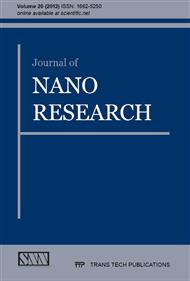[1]
Z.L. Wang, Self-Powered Nanotech, Sci. Am. (2008) 82-87.
Google Scholar
[2]
J.A. Paradiso, T. Starner, Energy Scavenging for Mobile and Wireless Electronics, Perv. Comput. 4 (2005) 18-27.
DOI: 10.1109/mprv.2005.9
Google Scholar
[3]
S. Roundy, E.S. Leland, J. Baker, E. Carleton, E. Beilly, E. Lai, B. Otis, J.M. Rabaey, P.K. Wright, V. Sundararajan, Improving Power Output for Vibration-Based Energy Scavengers, Perv. Comput. 5 (2005) 28-36.
DOI: 10.1109/mprv.2005.14
Google Scholar
[4]
P. Di Sia, An Analytical Transport Model for Nanomaterials, J. Comput. Theor. Nanosci. Vol. 8 (2011) 84-89.
Google Scholar
[5]
P. Di Sia, Classical and quantum transport processes in nano-bio-structures: a new theoretical model and applications, PhD Thesis (2011).
Google Scholar
[6]
J. Zhou, Y. Gu, P. Fei, W. Mai, Y. Gao, R. Yang, G. Bao, and Z.L. Wang, Flexible Piezotronic Strain Sensor, Nano Lett. Vol. 8 N. 9 (2008) 3035-3040.
DOI: 10.1021/nl802367t
Google Scholar
[7]
X.D. Wang, J. Zhou, J.H. Song, J. Liu, N.S. Xu, Z.L. Wang, Piezoelectric Field Effect Transistor and Nanoforce Sensor Based on a Single ZnO Nanowire, Nano Lett. 6 (2006) 2768-2772.
DOI: 10.1021/nl061802g
Google Scholar
[8]
C.S. Lao, Q. Kuang, Z.L. Wang, C. M. Park, Y. Deng, Polymer functionalized piezoelectric-FET as humidity/chemical nanosensors, Appl. Phys. Lett. 90 (2007) 262107-3.
DOI: 10.1063/1.2748097
Google Scholar
[9]
Z.L. Wang, Towards Self-Powered Nanosystems: From Nanogenerators to Nanopiezotronics, Adv. Funct. Mater. 18 (2008) 3553-3567.
DOI: 10.1002/adfm.200800541
Google Scholar
[10]
Z.L. Wang, X. Wang, J. Song, J. Liu, and Y. Gao, Piezoelectric Nanogenerators for Self-Powered Nanodevices, IEEE Perv. Comp. 7 (2008) 49-55.
DOI: 10.1109/mprv.2008.14
Google Scholar
[11]
P.H. Yeh, Z. Li, and Z.L. Wang, Schottky-Gated Probe-Free ZnO Nanowire Biosensor, Adv. Mater. 21 (2009) 4975-4978.
DOI: 10.1002/adma.200902172
Google Scholar
[12]
M. Ziman, Principles of the Theory of Solids, Cambridge University Press, New York, (1979).
Google Scholar
[13]
N.V. Smith, Classical generalization of the Drude formula for the optical conductivity, Phys. Rev. B 64 (2001) 155106-6.
Google Scholar
[14]
J. Han, W. Zhang, W. Chen, S. Ray, J. Zhang, M. He, A.K. Azad, and Z. Zhu, Terahertz Dielectric Properties and Low-Frequency Phonon Resonances of ZnO Nanostructures, J. Phys. Chem. C 111 (2007) 13000-13006.
DOI: 10.1021/jp073343t
Google Scholar
[15]
P. Di Sia, V. Dallacasa, F. Dallacasa, A Powerful Method to Describe Transport Properties of Nano and Bio Materials, J. Nano Res. Vol. 11 (2010) 45-56.
DOI: 10.4028/www.scientific.net/jnanor.11.45
Google Scholar
[16]
J.B. Baxter and C.A. Schmuttenmaer, Conductivity of ZnO Nanowires, Nanoparticles, and Thin Films Using Time-Resolved Terahertz Spectroscopy, J. Phys. Chem. B 110 (2006) 25229-25239.
DOI: 10.1021/jp064399a
Google Scholar


